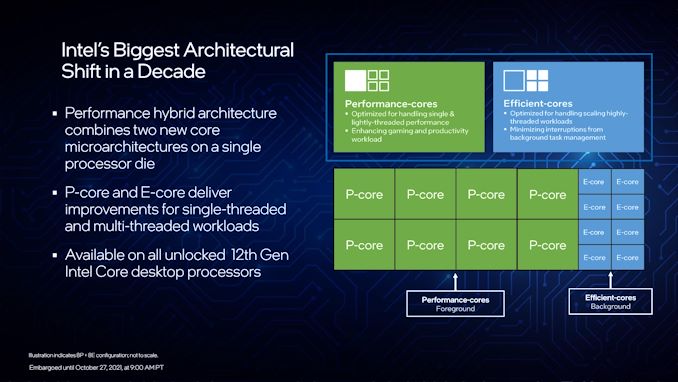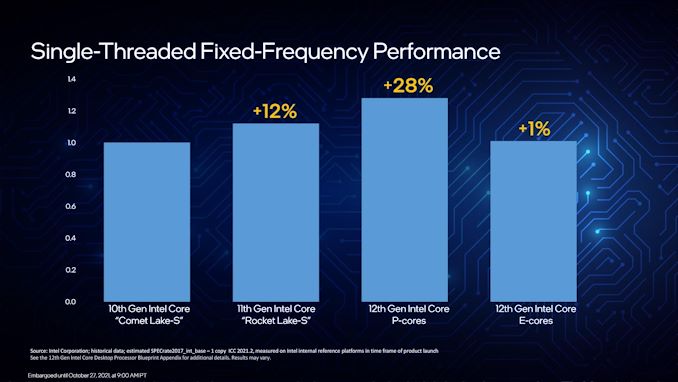Intel 12th Gen Core Alder Lake for Desktops: Top SKUs Only, Coming November 4th
by Dr. Ian Cutress on October 27, 2021 12:00 PM EST- Posted in
- CPUs
- Intel
- DDR4
- DDR5
- PCIe 5.0
- Alder Lake
- Intel 7
- 12th Gen Core
- Z690
A Hybrid/Heterogeneous Design
Developing a processor with two different types of core is not a new concept – there are billions of smartphones that have exactly that inside them, running Android or iOS, as well as IoT and embedded systems. We’ve also seen it on Windows, cropping up on Qualcomm’s Windows on Snapdragon mobile notebooks, as well as Intel’s previous Lakefield design. Lakefield was the first x86 hybrid design in that context, and Alder Lake is the more mass-market realization of that plan.
A processor with two different types of core disrupts the typical view of how we might assume a computer works. At the basic level, it has been taught that a modern machine is consistent – every CPU has the same performance, processes the same data at the same rate, has the same latency to memory, the same latency to each other, and everything is equal. This is a straightforward homogenous design that’s very easy to write software for.
Once we start considering that not every core has the same latency to memory, moving up to a situation where there are different aspects of a chip that do different things at different speeds and efficiencies, now we move into a heterogeneous design scenario. In this instance, it becomes more complex to understand what resources are available, and how to use them in the best light. Obviously, it makes sense to make it all transparent to the user.
With Intel’s Alder Lake, we have two types of cores: high performance/P-cores, built on the Golden Cove microarchitecture, and high efficiency/E-cores, built on the Gracemont microarchitecture. Each of these cores are designed for different optimization points – P-cores have a super-wide performance window and go for peak performance, while E-cores focus on saving power at half the frequency, or lower, where the P-core might be inefficient.
This means that if there is a background task waiting on data, or something that isn’t latency-sensitive, it can work on the E-cores in the background and save power. When a user needs speed and power, the system can load up the P-cores with work so it can finish the fastest. Alternatively, if a workload is more throughput sensitive than latency-sensitive, it can be split across both P-cores and E-cores for peak throughput.
For performance, Intel lists a single P-core as ~19% better than a core in Rocket Lake 11th Gen, while a single E-core can offer better performance than a Comet Lake 10th Gen core. Efficiency is similarly aimed to be competitive, with Intel saying a Core i9-12900K with all 16C/24T running at a fixed 65 W will equal its previous generation Core i9-11900K 8C/16T flagship at 250 W. A lot of that will be that having more cores at a lower frequency is more efficient than a few cores at peak frequency (as we see in GPUs), however an effective 4x performance per watt improvement requires deeper investigation in our review.
As a result, the P-cores and E-cores look very different. A deeper explanation can be found in our Alder Lake microarchitecture deep dive, but the E-cores end up being much smaller, such that four of them are roughly in the same area as a single P-core. This creates an interesting dynamic, as Intel highlighted back at its Architecture Day: A single P-core provides the best latency-sensitive performance, but a group of E-cores would beat a P-core in performance per watt, arguably at the same performance level.
However, one big question in all of this is how these workloads end up on the right cores in the first place? Enter Thread Director (more on the next page).
A Word on L1, L2, and L3 Cache
Users with an astute eye will notice that Intel’s diagrams relating to core counts and cache amounts are representations, and some of the numbers on a deeper inspection need some explanation.
For the cores, the processor design is physically split into 10 segments.
A segment contains either a P-core or a set of four E-cores, due to their relative size and functionality. Each P-core has 1.25 MiB of private L2 cache, which a group of four E-cores has 2 MiB of shared L2 cache.
This is backed by a large shared L3 cache, totaling 30 MiB. Intel’s diagram shows that there are 10 LLC segments which should mean 3.0 MiB each, right? However, moving from Core i9 to Core i7, we only lose one segment (one group of four E-cores), so how come 5.0 MiB is lost from the total L3? Looking at the processor tables makes less sense.
Please note that the following is conjecture; we're awaiting confirmation from Intel that this is indeed the case.
It’s because there are more than 10 LLC slices – there’s actually 12 of them, and they’re each 2.5 MiB. It’s likely that either each group of E-cores has two slices each, or there are extra ring stops for more cache.
Each of the P-cores has a 2.5 MiB slice of L3 cache, with eight cores making 20 MiB of the total. This leaves 10 MiB between two groups of four E-cores, suggesting that either each group has 5.0 MiB of L3 cache split into two 2.5 MiB slices, or there are two extra LLC slices on Intel’s interconnect.
| Alder Lake Cache | |||||||
| AnandTech | Cores P+E/T |
L2 Cache |
L3 Cache |
IGP | Base W |
Turbo W |
Price $1ku |
| i9-12900K | 8+8/24 | 8x1.25 2x2.00 |
30 | 770 | 125 | 241 | $589 |
| i9-12900KF | 8+8/24 | 8x1.25 2x2.00 |
30 | - | 125 | 241 | $564 |
| i7-12700K | 8+4/20 | 8x1.25 1x2.00 |
25 | 770 | 125 | 190 | $409 |
| i7-12700KF | 8+4/20 | 8x1.25 1x2.00 |
25 | - | 125 | 190 | $384 |
| i5-12600K | 6+4/20 | 6x1.25 1x2.00 |
20 | 770 | 125 | 150 | $289 |
| i5-12600KF | 6+4/20 | 6.125 1x200 |
20 | - | 125 | 150 | $264 |
This is important because moving from Core i9 to Core i7, we lose 4xE-cores, but also lose 5.0 MiB of L3 cache, making 25 MiB as listed in the table. Then from Core i7 to Core i5, two P-cores are lost, totaling another 5.0 MiB of L3 cache, going down to 20 MiB. So while Intel’s diagram shows 10 distinct core/LLC segments, there are actually 12. I suspect that if both sets of E-cores are disabled, so we end up with a processor with eight P-cores, 20 MiB of L3 cache will be shown.













395 Comments
View All Comments
Flying Aardvark - Thursday, October 28, 2021 - link
That's a design decision that's focused on mobile. Clearly it won't hurt gaming performance. BTW AMD is moving to hetero cores too, they're simply behind the curve right now.Gigaplex - Wednesday, October 27, 2021 - link
I care about the noise levels.Spunjji - Thursday, October 28, 2021 - link
I'll happily also save $100 on the CPU cooler, though... and that's before we get to the extra platform costs. Those are some pricey boards thanks to the early adopter tax and chonky VRMs needed, and DDR5 is paaaiiinfully expensive.factual - Thursday, October 28, 2021 - link
Whether the energy savings is $10, or less, or more, or none at all is unknown. What Anandtech should do is measure the power consumption of Alder Lake while playing various games and compare it against power consumption of Zen3 while playing the same games. That would be a realistic power consumption comparison. Most people rarely fully load their CPUs, so comparing power consumption while playing demanding games is the most useful metric IMO.Spunjji - Friday, October 29, 2021 - link
If you're a gamer, for sure. If you're not, those numbers aren't terribly useful. The problem is that it increases their workload substantially and doesn't necessarily give a clearer picture.Meteor2 - Monday, November 1, 2021 - link
Lots of people here are gamers. And rather obviously, just extend the test to compiling, rendering etcJosh128 - Wednesday, October 27, 2021 - link
Lol, you can likely upgrade to a Zen 3 + using your same mobo in a couple months, needing only a CPU. Going Intel will require $1000 for new mobo, RAM, and CPU. Think about that for a second.Tilmitt - Wednesday, October 27, 2021 - link
He probably can't upgrade because AMD are deliberately sabotaging older motherboard support for their newer CPUs.Gigaplex - Thursday, October 28, 2021 - link
No they're not.kobblestown - Thursday, October 28, 2021 - link
Well, they tried to. Sure, at the end they listened to customers rather than to MoBo makers (who are also their customers, BTW) but this cannot be taken for granted. Look what they did to the ThreadRipper platform.Don't get me wrong, I'm typing this on an 3600X/X470, my laptop has 5700U and my server is TR1920X. My next CPU will also be AMD by the looks of it. But let's not pretend they are "nice". They are a company and will do everything to maximize their profits. Being the underdog, they have to play it nice. But once their marketshare started growing they took some pages out of Intel's book. The only thing that can keep them in check is competition. That's why I root for Intel in this case. Of course, Intel are effectively lying about AlderLake's performance (using unpatched Windows 11 - how conveniently that crippled Zen's performance!) but the faster ADL turns out to be, the better for AMD customers.